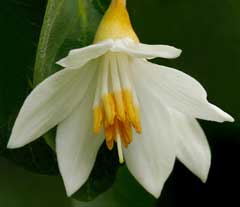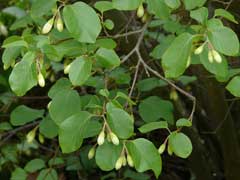 |
|
http://www.flickr.com/photos/jim-sf |
 |
| http://www.flickr.com/photos/jim-sf |
Translate this page:
Summary
Physical Characteristics

 Styrax officinalis is a deciduous Shrub growing to 5 m (16ft) by 2 m (6ft) at a slow rate.
Styrax officinalis is a deciduous Shrub growing to 5 m (16ft) by 2 m (6ft) at a slow rate.
See above for USDA hardiness. It is hardy to UK zone 9 and is frost tender. It is in flower in June, and the seeds ripen in October. The species is hermaphrodite (has both male and female organs).
Suitable for: light (sandy) and medium (loamy) soils and prefers well-drained soil. Suitable pH: mildly acid and neutral soils. It can grow in semi-shade (light woodland) or no shade. It prefers moist soil and can tolerate drought.
UK Hardiness Map
US Hardiness Map
Synonyms
Plant Habitats
Woodland Garden Secondary; Sunny Edge; South Wall. By. West Wall. By.
Edible Uses
Edible Parts:
Edible Uses: Condiment
A highly perfumed balsamic gum is obtained from the branches and stems[183]. It is occasionally used as a condiment[183]. This gum is almost certainly the resin described below[K].
References More on Edible Uses
Medicinal Uses
Plants For A Future can not take any responsibility for any adverse effects from the use of plants. Always seek advice from a professional before using a plant medicinally.
Antiseptic Expectorant
A resin obtained from the stems of the plant is antiseptic and expectorant[11, 103, 240].
References More on Medicinal Uses
The Bookshop: Edible Plant Books
Our Latest books on Perennial Plants For Food Forests and Permaculture Gardens in paperback or digital formats.

Edible Tropical Plants
Food Forest Plants for Hotter Conditions: 250+ Plants For Tropical Food Forests & Permaculture Gardens.
More

Edible Temperate Plants
Plants for Your Food Forest: 500 Plants for Temperate Food Forests & Permaculture Gardens.
More

More Books
PFAF have eight books available in paperback and digital formats. Browse the shop for more information.
Shop Now
Other Uses
Beads Resin
The fragrant resin 'storax' is obtained by wounding the stem[64, 89]. It is used medicinally, in perfumes, incense etc[11, 148]. The fruits are used as beads in rosaries etc[89, 148, 182].
Special Uses
Scented Plants
References More on Other Uses
Cultivation details
Requires a light lime-free soil in sun or semi-shade[11, 200]. If planted out when young into a planting hole that has been filled with a light lime-free soil the plants will successfully grow into the surrounding soil[11]. Prefers a warm sheltered position with protection from the morning sun[11]. Dislikes wet soils. Established plants are drought tolerant, they grow better in Britain when the summer is dry. This species is not very hardy outdoors in Britain. Dormant plants tolerate temperatures down to about -5°c[200] but the young growth is liable to be damaged by late frosts[11]. Succeeds in the milder parts of the country[1]. Plants were growing and fruiting well on a west-facing wall at Kew in 1992[K]. Plants do not flower freely unless in a warm sunny spot or on a south facing wall[182]. The flowers are very fragrant[219]. Plants in this genus are notably resistant to honey fungus[200].
References Carbon Farming Information and Carbon Sequestration Information
Temperature Converter
Type a value in the Celsius field to convert the value to Fahrenheit:
Fahrenheit:
The PFAF Bookshop
Plants For A Future have a number of books available in paperback and digital form. Book titles include Edible Plants, Edible Perennials, Edible Trees,Edible Shrubs, Woodland Gardening, and Temperate Food Forest Plants. Our new book is Food Forest Plants For Hotter Conditions (Tropical and Sub-Tropical).
Shop Now
Plant Propagation
Seed - requires stratification and is best sown in a cold frame as soon as it is ripe[11]. Stored seed requires 3 months warm then 3 months cold stratification[113]. Germination is usually good, prick out the seedlings into individual pots once they are large enough to handle. Overwinter in a greenhouse for the first winter and plant out in late spring. Cuttings of half-ripe wood, July/August in a frame[113]. Layering in autumn.
Other Names
If available other names are mentioned here
Native Range
TEMPERATE ASIA: Cyprus, Israel, Jordan, Lebanon, Syria, Turkey EUROPE: Albania, Greece (incl. Crete), Croatia, Italy
Weed Potential
Right plant wrong place. We are currently updating this section.
Please note that a plant may be invasive in one area but may not in your area so it's worth checking.
Conservation Status
IUCN Red List of Threatened Plants Status :

Growth: S = slow M = medium F = fast. Soil: L = light (sandy) M = medium H = heavy (clay). pH: A = acid N = neutral B = basic (alkaline). Shade: F = full shade S = semi-shade N = no shade. Moisture: D = dry M = Moist We = wet Wa = water.
Now available:
Food Forest Plants for Mediterranean Conditions
350+ Perennial Plants For Mediterranean and Drier Food Forests and Permaculture Gardens.
[Paperback and eBook]
This is the third in Plants For A Future's series of plant guides for food forests tailored to
specific climate zones. Following volumes on temperate and tropical ecosystems, this book focuses
on species suited to Mediterranean conditions—regions with hot, dry summers and cool, wet winters,
often facing the added challenge of climate change.
Read More
Expert comment
Author
L.
Botanical References
1145200
Links / References
For a list of references used on this page please go here
Readers comment
| Add a comment |
|
If you have important information about this plant that may help other users please add a comment or link below. Only comments or links that are felt to be directly relevant to a plant will be included. If you think a comment/link or information contained on this page is inaccurate or misleading we would welcome your feedback at [email protected]. If you have questions about a plant please use the Forum on this website as we do not have the resources to answer questions ourselves.
* Please note: the comments by website users are not necessarily those held by PFAF and may give misleading or inaccurate information.
To leave a comment please Register or login here All comments need to be approved so will not appear immediately.
|
Subject : Styrax officinalis
|
|
|
|